|
feature WORKING FOR THE LIVING: A Day in the Life of a Funeral Home by Mira Ptacin Photography: Erika Preuss David Brennan is a thin-lipped, quick man with a Santa Claus mustache and bushy white hair. All his life, he’s been teased with “Captain Kangaroo,” to whom he bears a striking resemblance. In no particular order, David loves his basset hound, Wally; his wife; his two kids; andóhis job. After receiving his undergraduate degree in theater, David worked as an English teacher and as a banker, but now, at 53, he’s doing what he feels he should have done years ago. Every day at 6:30 a.m. David leaves his home to work as a funeral home director. The anticipation of the day is usually dampened by the early morning grogginess and long walk to Hobbs Funeral Home, but he never expects any kind of routine. David is usually the first to arrive and last to leave the big white clapboard house at 230 Cottage Road, one of Portland, Maine’s few remaining family-owned and operated funeral homes. 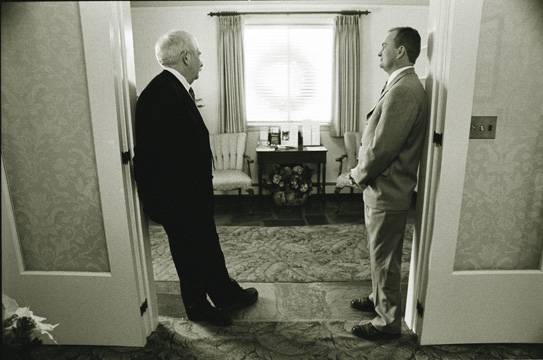
It’s the last stretch of a lazy fall evening, not quite time to turn in, and David’s narrow gap before bedtime was supposed to be filled by clearing a space in his cellar for his new candle-making hobby. At 9:15 the phone rings. A patient at New England Rehab has just died and David is on call. He takes a breath, throws on his overcoat and dutifully treads back to Hobbs Funeral Home. It had rained heavily all day and the cool light of the moon sparkles off the blacktop. It’s only sprinkling now, and chilly enough to see your breath. The garage of the funeral home opens and David pops open the back of the polished black minivan and pushes in the gurney. Its thin front legs fold up as he jerks it into the edge of the trunk. Tonight is only a one-man job, but that doesn’t mean there won’t be a lot of lifting. Itís 9:30 p.m. and the van veers into the back entrance of the Outpatient Center where just a few cars pepper the parking lot. He turns off the ignition, opens the back, and yanks out the gurney. David leaves the van unlocked and enters through the back door of the hospital. From behind their carts stacked with feather dusters, Kleenex boxes and disinfectants, a couple of night janitors pitch a closed-mouth smile to David as he wheels the gurney down the linoleum corridors. David, expressionless, asks a nurse in aqua scrubs, “Need a lift?” The nurse laughs out loud, and David doesn’t, as he rounds the corner to the front desk. “David Brennan here from Hobbs for the pickup.” 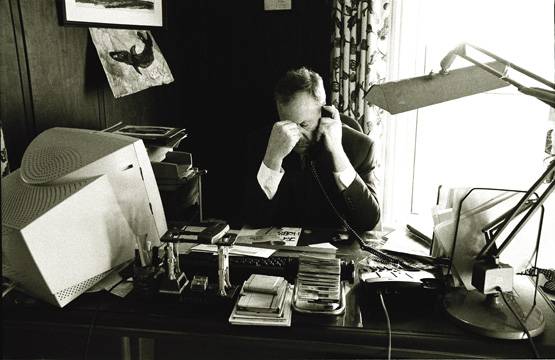
Before working for Hobbs, David was employed at a corporate funeral home, but quit not long after. “I knew about six months in that it was just a matter of time. I said, ‘This is it, no more.’” “They do the whole soup ta’ nuts. They’ll go in and buy one funeral home, they’ll buy another funeral home, they’ll buy any funeral home. And that’s fine, they retain the family entity that everyone’s familiar with, but the family will be on salary working for the corporation, and the corporation calls the shots.” Several years ago, a national funeral provider browsed into Maine and purchased nearly thirty independent funeral homes. They made generous offers to Hobbs Funeral Home, but the family consistently declined. “They said, ‘There’s the back door, don’t let it hit you on the way out.’” The conglomerate offered to buy the funeral home for millions, some in cash and some in stock. But the Hobbs were wise and, after the bottom fell out of the stock market, many former funeral home owners suddenly held thousands in useless paper. “A lot of times someone will sell their funeral home to the big guys and just move on, get out of the area, retire, go to Florida, whatever. Then the conglomerate will send its own people in. The towns they go into, they don’t know the people, all the little quirks and the nuances and everything that you have to deal with. Here, as long as a Hobbs is in charge, this won’t go the way of a corporation.” 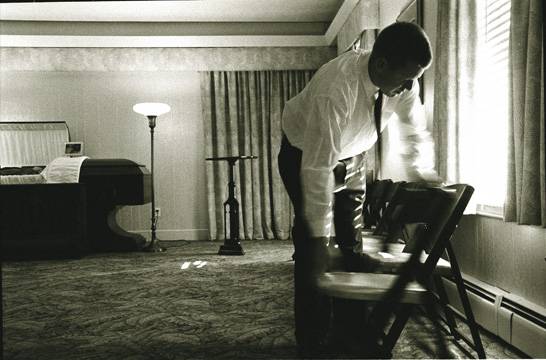
At the hospital, David stations the gurney at the desk and looks at the two seasonal Halloween skeletons next to him, one garbed in a wedding dress and one in a tuxedo. He slouches, folds his arms across the chest of his own dark olive suit and glances around the sleepy room until a nurse leads him to where a patient died just under two hours before. The naked body is wrapped in thin, white plastic from top to bottom, and the feet are pigeon-toed. “His dentures are on top of his chest,” the nurse says. David pulls the gurney parallel to the hospital bed. In the corner of the room, a plastic bag of the deceased’s belongings rests on a blue felt chair. Some magazines, a novel, and a book of crossword puzzles peek out. David unzips the gray cloth cover on the gurney, unbuckles the seat belt straps and leans over to slide the body onto it. The body is light and thin, but still limp, presenting a challenge for David. He slides his palms underneath the body and scoops it onto the gurney, all the while attempting to be gentle, efficient, and respectful. Once the body is strapped in and zipped up, David signs a release form and pushes the gurney back to the van. He loads it in, slams the doors, turns on the ignition and the defogger. The radio dial is tuned to local country rock station, and the lyrics She thinks my tractor’s sexy roll through the vehicle. Soon, David is backing the black van into the funeral home garage. He unloads the body into the embalming room, then walks home. 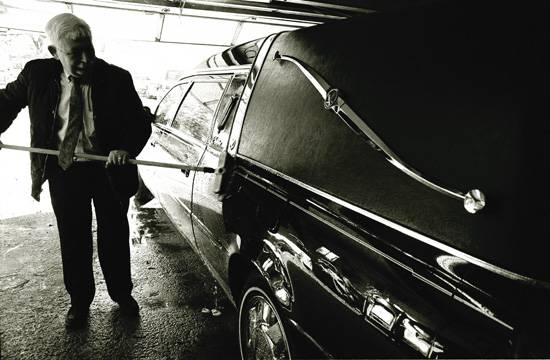
It’s the morning before Halloween, and Thursday’s dawn is breaking. Itís 6:15 a.m., and David, already up and out, escorts his dog Wally inside from his morning walk. David grabs his keys off the kitchen stove and steps into the living room. He slings his tie around his neck, zips up his fleece and steps out the door of his home on Mussy Street. He passes his silver VW Bug, tosses a wave to a neighbor driving to work, passes the brown fence with the brown dog that barks at him every day, and strides past the Mount Pleasant cemetery spotted with white tombstones. When David unlocks the garage door to Hobbs Funeral Home, the persistent shrill of the security alarm bounces off the cement walls until he squeezes past the sleeping hearse and minivan and punches in the code. Inside the funeral home, the parlors are pitch black, and a leftover smell of gardenias, or, perhaps, lilies, lingers. David finds his way to the first lamp with the sliver of light shining from the garage. He twists the copper knobs, flips on plastic light-switches, and winds up the grandfather clock. A door in the wood-paneled meeting room kicks open and Mrs. Hobbs slowly shuffles in, her walker rolling along the mint-green and pink carpet. She’s petite and has a warm sweetness about her, perhaps one only attainable by grandmothers. Matriarch of the funeral home, Elizabeth Hobbs (Betty to friends, and Meem to grandchildren) started this business with her late husband Frank over sixty years ago, and she has watched it pass through three generations of her family. Hobbs is now one of the two funeral homes still independently owned and operated in South Portland. The rest have sold to conglomerates. “Good morning, Mrs. Hobbs,” David greets her. “Good morning, David. How are you?” Her voice squeaks out, but with a sense of authority. Mrs. Hobbs is 87 years old and drives the metallic silver PT Cruiser parked out back. She lives upstairs at the funeral home where she raised her three children. She and her husband bought this building in 1941 when they were in their early 20’s. “I saw this sign out front, ‘House for Sale’,” she says, “and I went back to our home and said, ‘Frank, I found a house that would make a lovely funeral home.’” The Hobbs conducted their very first funeral on December 7, 1941, the same day Pearl Harbor was attacked. The family was so busy borrowing chairs and setting up, they didn’t realize a war had begun. 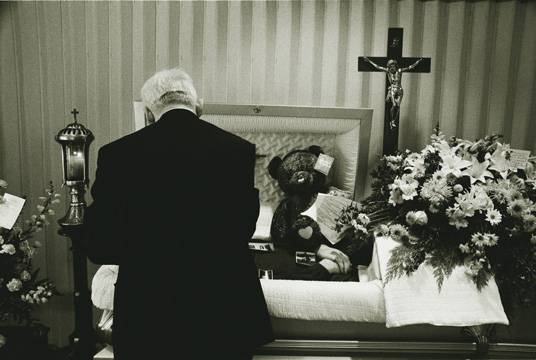
David unlocks the casket showroom. He surveys the space; a pile of caskets sit in the center. Some are wooden, some metal. The more expensive ones guarantee a longer preservation of the body, less leakage, and airtight sealing. “So the clients can have peace of mind,” he says. Above a shelf of urns, a poster depicts a dump truck driving over a deteriorating casket. It illustrates why it is necessary to also purchase a vault: in time the casket will rot and the ground above will sink in if there is no cement vault encasing it. Hobbs Funeral Home sells different styles of vaults: the Monticello, the Continental, the Venetian, and the pink Cameo Rose. All different colors, and all with the essence and elegance of, say, a Lincoln Town Car. “Bury me under the rose bush, in the back yard,” David says, “I don’t care. I don’t really know what happens after we die.” But for the sake of those who do survive him, David wants a decent funeral. He’d like to be embalmed and have a traditional service, with a wake, an open casket, tears, flowers, everything. It’s not for him; he’ll be long gone, as he puts it. It’s for his family. He knows that embalming is unnatural and that it doesn’t really matter how long a casket preserves a body or keeps it airtight, but he wants his family to feel comforted. “I’ve heard many clergymen say, ‘Death is just another stage of life.’ You go through a doorway and into a room that we don’t know about. Working here for me is trying to help those left behind deal with the fact. It’s not for the dead, but for the living.” David says the Hobbs family is not here to sell caskets or make a dollar. To him and to them it’s about the service, and, being a family-operated business, they can cut corners and knock off a few dollars here and there. Just last Christmas, he says, they gave two free funerals: a mother of nine without a dollar to her name; then, a 10-year-old boy fell through the ice and his family couldn’t afford to hold a service. “Their business is ministry, not ministry as a business,” David sighs, and dusts off the Continental. He slips a key out from his pocket. “And this locks everything up, keeps it airtight.” 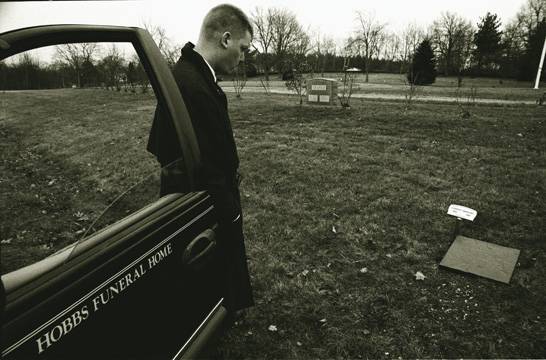
Two bodies are in the embalming room. One has already been prepared, and David is setting up for the next. The funeral is the next day and there is work to be done. David says that the embalming procedure isn’t required by law, nor does it provide any public health benefit. It doesn’t preserve a body forever, it merely delays the inevitable consequences of death. Years ago, when transportation was slower and people traveled long distances, the chemical part of embalming kept bodies somewhat “fresh” until the funeral. Now travel is quicker and funerals are held sooner after death. Embalming is more of a tradition than a necessity. Nowadays, cremation is more popular. David places the embalmed body on a porcelain table and washes it with germicide. “Embalming is my specialty; I have experience working with makeup from my theater background.” He works massage cream into the face and hands to keep the skin soft and pliable to relieve rigor mortis. During the first part of embalming, or “arterial embalming”, David injects two or so gallons of formaldehyde into an artery to replace blood drained from the body. During the second stage, “cavity embalming”, David inserts a trocar, a long, pointed metal tube attached to a suction hose, into the abdomen of the corpse to withdraw gas and fluids. He injects cavity fluid, a stronger mix of formaldehyde, into the torso, then sets the facial features by inserting cotton into the nose, places eye caps under the eyelids and a mouth former to set the mouth. The mouth is then tied closed with wires and glued to keep the lips sealed in an appropriate pose. He packs cavities with cotton or gauze to prevent seepage, sews incisions, fills in holes made in the body with trocar “buttons”, washes and dries the body, manicures the nails, applies the makeup, styles the hair and the body is all set: prepped. “It gets to me when it’s a baby or a child,” he says. “One of the first cases I ever had to work with was a little girl that was six years old. I had a son that was six at the time. And I knew as soon as I took it out off the wrappings when we got it from the hospital—I mean, there’s a child, a baby. Didn’t have a chance to go any further in life .” By 10 a.m. the heart of the funeral home is pumping away. The rest of the team has arrived and papers are shuffling everywhere. Churches are being contacted, obituaries typed, documents organized and flowers delivered. Around noon, the phone rings. A body that flew in from Boston needs to be taken to the crematorium today. Everyone is busy with one thing or another and Jeff Hobbs Jr. gets voted to do the delivery. “The cause of death was lung cancer, right?” David asks, without looking up from his paperwork. He slides the paper out of the typewriter and hands it to Jeff. As Jeff trots down the stairs to the garage, David shouts, “Be sure to check for a pacemaker so nothing explodes in the incinerator.” “You won’t have to worry about that with David when he dies,” teases Jeff, “cause he doesn’t have a heart.” 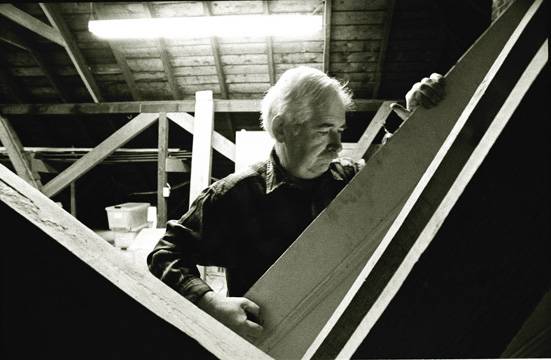
David stands on top of the front steps to the chapel, facing the street with his arms around his back, chin lifted a bit. It’s raining hard and guest are arriving every few minutes in overcoats and umbrellas. “This is what I call the less glamorous part of being a funeral director,” David says, as rain pelts his coat. His hair soggy, he pulls open the doors to the chapel already filled with people. Chords of the organ flutter outside into the wet air. In pews, men sit slouched with their arms around their wives and kids are silent, knowing that this is not the time to misbehave. Everything is quiet, except for a few sniffles and the deep whisper of the directors ushering people to their seats. The ceremony concludes with music: “On Eagle’s Wings,” and those in the crowd slowly drift out of their reflections and back into the reality of the moment. They look around awkwardly, unsure of what to do and where to go. Then, almost as if floating out of the walls, the funeral directors step into the aisle of the chapel. David pierces the first rows with his eyes, then motions with a sharp hand movement to proceed this way. Like dominoes falling, the pews clear under the smooth and confident guidance of the directors. In no time, David is paged to do another body pickup and leaves the funeral early. It’ll be another late night, but, David knows, it’s only to be expected, day after day, year after year,when youíre working for the living.
fiction poetry "fact" photography masthead guidelines |